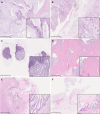Acellular mucin in neoplastic and non-neoplastic conditions of the lower gastrointestinal tract
- PMID: 40740892
- PMCID: PMC12305226
- DOI: 10.4240/wjgs.v17.i7.106672
Acellular mucin in neoplastic and non-neoplastic conditions of the lower gastrointestinal tract
Abstract
Acellular mucin refers to pools of mucin without epithelial component, oftentimes harboring inflammatory cells. Acellular mucin can be observed in both neoplastic and non-neoplastic lower gastrointestinal (GI) conditions. While mucinous neoplasms are classified and staged using established guidelines, interobserver variability occurs when acellular mucin pools are encountered, leading to inconsistent interpretation and staging. In particular, acellular mucin found in regional lymph nodes of colorectal adenocarcinoma patients who have not received treatment presents a diagnostic challenge, as its prognostic implication is not clearly defined. Acellular mucin is also commonly seen in treated colorectal adenocarcinoma, post neoadjuvant therapy. Although acellular mucin is not counted toward T or N staging in this setting, variation in how pathologists report and stage these cases persists. Acellular mucin can also be seen in non-neoplastic specimens, such as those from interval appendectomies, appendiceal diverticula, colonic diverticulitis, volvulus, and Crohn's disease where it may mimic a neoplastic lesion. Acellular mucin in this setting is often a byproduct of inflammation, increased luminal pressure, and mural defect. This review highlights the clinical relevance and diagnostic complexity of acellular mucin in pathologic conditions of the lower GI tract. Further studies are needed to clarify its prognostic value and develop standardized guidelines.
Keywords: Acellular mucin; Interval appendectomy; Low-grade appendiceal mucinous neoplasm; Mucinous adenocarcinoma; Pseudomyxoma peritonei.
©The Author(s) 2025. Published by Baishideng Publishing Group Inc. All rights reserved.
Conflict of interest statement
Conflict-of-interest statement: All authors declare no conflicts-of-interest related to this article.
Figures


Similar articles
-
Management of urinary stones by experts in stone disease (ESD 2025).Arch Ital Urol Androl. 2025 Jun 30;97(2):14085. doi: 10.4081/aiua.2025.14085. Epub 2025 Jun 30. Arch Ital Urol Androl. 2025. PMID: 40583613 Review.
-
Idiopathic (Genetic) Generalized Epilepsy.2024 Feb 12. In: StatPearls [Internet]. Treasure Island (FL): StatPearls Publishing; 2025 Jan–. 2024 Feb 12. In: StatPearls [Internet]. Treasure Island (FL): StatPearls Publishing; 2025 Jan–. PMID: 31536218 Free Books & Documents.
-
Variation within and between digital pathology and light microscopy for the diagnosis of histopathology slides: blinded crossover comparison study.Health Technol Assess. 2025 Jul;29(30):1-75. doi: 10.3310/SPLK4325. Health Technol Assess. 2025. PMID: 40654002 Free PMC article.
-
Cost-effectiveness of using prognostic information to select women with breast cancer for adjuvant systemic therapy.Health Technol Assess. 2006 Sep;10(34):iii-iv, ix-xi, 1-204. doi: 10.3310/hta10340. Health Technol Assess. 2006. PMID: 16959170
-
The Black Book of Psychotropic Dosing and Monitoring.Psychopharmacol Bull. 2024 Jul 8;54(3):8-59. Psychopharmacol Bull. 2024. PMID: 38993656 Free PMC article. Review.
References
-
- Ersöz CC, Ersöz S, Savas B, Ensari A. Low-Grade Appendiceal Mucinous Neoplasm vs. Appendiceal Diverticulum: Distinction with Histomorphologic Features. Gastrointest Disord. 2024;6:905–915.
-
- Ballentine SJ, Carr J, Bekhor EY, Sarpel U, Polydorides AD. Updated staging and patient outcomes in low-grade appendiceal mucinous neoplasms. Mod Pathol. 2021;34:104–115. - PubMed
-
- Kim S, Huh JW, Lee WY, Yun SH, Kim HC, Cho YB, Park Y, Shin JK. Prognostic Impact of Mucinous Adenocarcinoma in Stage II and III Colon Cancer. Dis Colon Rectum. 2023;66:1473–1480. - PubMed
Publication types
LinkOut - more resources
Full Text Sources

